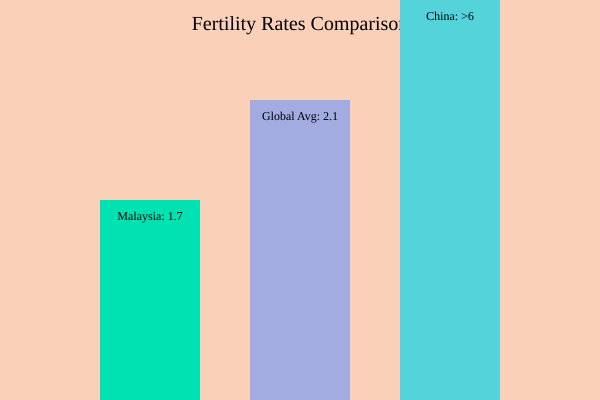
Picture a bustling city filled with young professionals, each one focused on career pursuits and personal endeavors. As we navigate this modern landscape, an unsettling truth emerges—birth rates are dropping. In Malaysia, the fertility rate has plummeted to 1.7, far below the replacement level of 2.1 needed to keep the population stable. What does this mean for our future? Are we facing a ticking time bomb that could unravel the fabric of our society? In this article, we’ll unpack the trends and consequences behind these staggering statistics.
The Fertility Rate Crisis: Understanding the Numbers
The issue of declining birth rates is becoming a pressing concern in many countries, especially in Malaysia. As of 2023, Malaysia’s total fertility rate (TFR) stands at 1.7 babies per woman. This is significantly below the global replacement level of 2.1. What does this mean for the future of the nation? It indicates a rapidly shrinking younger population, which could lead to serious socio-economic challenges.
Current Fertility Rates
- Malaysia: 1.7 babies per woman
- Global Average: 2.1 babies per woman
- China’s Peak TFR: Over 6 babies per woman in the 1960s
To maintain population stability, countries need a total fertility rate of at least 2.1 babies per woman. This figure is crucial for ensuring that the population can replace itself over time. When the TFR drops below this level, it raises concerns about an aging population and a shrinking workforce.
Comparative Analysis
Historically, the world faced different challenges regarding population growth. In the 1960s, China had a TFR exceeding six. This led to the infamous one-child policy introduced in 1979. Today, even with measures to encourage larger families, China’s birth rate continues to decline.
Malaysia’s situation is not unique. Many countries in the Asia-Pacific region are experiencing similar trends. Urbanization plays a significant role. People are moving from rural areas to cities like Kuala Lumpur, Johor Bahru, and Penang. In these urban centers, family dynamics shift. Work opportunities often take precedence over starting a family.
Financial Implications
Financial considerations also heavily influence decisions about parenthood. Raising a child in Malaysia can cost between RM 393,000 and RM 1.4 million from birth to university. In Kuala Lumpur, expenses can be particularly high. For instance, the average cost of pregnancy can reach RM 69,300. With the median salary in Malaysia around RM 2,700, many young couples find it challenging to manage these costs.
Demographic Shifts
As fewer children are born, Malaysia faces significant demographic shifts. The largest age group has moved from 10-14 years to 30-34 years over the past two decades. By 2040, the elderly population is expected to rise from 5% in 2020 to 14.5%. This shift could stifle economic growth and lead to increased reliance on government support.
In response, the Malaysian government has initiated measures to encourage higher birth rates. These include tax incentives and subsidies for fertility treatments. However, these efforts still lag behind neighboring countries like Singapore, which offers substantial financial incentives for families.
Chart: Fertility Rates Comparison


Urbanization: A Double-Edged Sword
Urbanization is reshaping societies across the globe. In Malaysia, the trend of migration from rural areas to urban centers is particularly pronounced. People are flocking to cities like Kuala Lumpur (KL) and Penang in search of better job opportunities. But what does this mean for family planning and perceptions around having children?
Migration Trends
As individuals move to urban areas, they often prioritize their careers over starting families. This shift has significant implications for fertility rates. Urban areas like KL and Penang report lower fertility rates compared to rural states. For instance, the fertility rate in Penang stands at a mere 1.3, while rural areas boast averages above 2.5. This stark contrast raises questions about the future of family structures in Malaysia.
Impact on Family Planning
Living in urban environments brings about a change in how families view child-rearing. Financial responsibilities weigh heavily on the minds of young couples. The cost of raising a child can be staggering, often leading many to postpone marriage and parenthood. The Agensi Kaunseling dan Pengurusan Kredit (AKPK) estimates that raising a child can cost anywhere from RM 393,000 to RM 1.4 million from birth to university. With the median salary in Malaysia hovering around RM 2,700, this financial burden can be daunting.
Changing Perceptions
Urbanization has also altered perceptions surrounding children. Many now equate having children with significant financial responsibilities. As one expert noted,
“Urbanization has reshaped our priorities, affecting the traditional view of family and children.”
This shift in mindset can lead to fewer children being born, further contributing to declining birth rates.
Urban vs. Rural Fertility Rates
The difference in fertility rates between urban and rural areas is striking. The following table illustrates this disparity:
| Location | Fertility Rate |
|---|---|
| Penang (Urban) | 1.3 |
| Rural Areas | Above 2.5 |
This table highlights the challenges faced by urban families. As cities grow, the traditional family structure is evolving. The implications of these changes are profound, affecting not just individual lives but also the socio-economic fabric of the nation.
In summary, urbanization is a double-edged sword. While it brings opportunities, it also poses challenges for family planning and perceptions around having children. As Malaysia continues to urbanize, the need for a balanced approach to these issues becomes increasingly crucial.
The Financial Burden of Parenthood in Malaysia
Parenthood is a profound journey, but it comes with significant financial challenges. In Malaysia, the cost of raising a child is estimated to be between 393,000 to 1.4 million ringgit. This staggering figure raises questions about how families can manage such expenses. What does this mean for young couples considering starting a family?
Breaking Down the Costs
Understanding the financial implications of raising a child involves analyzing various stages of life. From pregnancy to university, each phase incurs its own set of costs. For instance:
- Pregnancy and Delivery: The average cost associated with pregnancy can reach 69,300 ringgit.
- Education: Costs vary immensely depending on whether families choose government or private schooling options.
These expenses can add up quickly, making it essential for families to plan ahead. The average monthly cost of raising a child is around 1,324 ringgit. With the median salary in Malaysia being approximately 2,700 ringgit, this financial burden represents nearly 16% of a household’s total income. How can families balance these figures?
Comparative Analysis: Salaries vs. Raising Costs
The disparity between salaries and the costs of raising children is stark. As the median salary hovers around 2,700 ringgit, families are left with limited disposable income after accounting for child-rearing expenses. This situation often leads to tough decisions about family planning.
Many young couples may find themselves postponing marriage and children due to financial constraints. The reality is that the financial demands of raising children starkly contrast with current income levels. This disparity can significantly impact family planning decisions.
Financial Implications for Young Families
As noted by experts,
“Raising a child in urban Malaysia now represents nearly 16% of a household’s total income.”
This statistic highlights the weight of financial responsibilities on young families. With rising costs and stagnant wages, the dream of parenthood can feel increasingly out of reach.
In summary, the financial burden of parenthood in Malaysia is a pressing issue. Families must navigate the complex landscape of expenses, from pregnancy to education, all while managing their income. The challenge is not just about affording a child; it’s about ensuring a stable future for them as well.
Visualizing the Financial Landscape
To better understand these financial dynamics, the following chart illustrates the costs associated with raising a child in Malaysia:
// Chart data
const chartData = {
labels: ['Minimum Cost', 'Average Monthly Cost', 'Median Salary'],
datasets: [{
label: 'Financial Overview',
data: [393000, 1324, 2700],
backgroundColor: ['rgba(75, 192, 192, 0.6)', 'rgba(153, 102, 255, 0.6)', 'rgba(255, 159, 64, 0.6)'],
}]
};

Aging Population: Implications for the Future
The world is witnessing a significant shift in population demographics. This change is particularly evident in Malaysia, where the elderly population is projected to increase dramatically. By 2040, the percentage of elderly individuals is expected to rise from 5% to a staggering 14.5%. This shift raises important questions about the future of society. How will this aging population impact the economy? What challenges will healthcare systems face?
Shifts in Population Demographics
As birth rates decline, the demographic landscape is changing. In Malaysia, the total fertility rate (TFR) is currently at 1.7 babies per woman, far below the replacement level of 2.1. This trend indicates a shrinking younger population. Urbanization plays a role here. Many individuals migrate to cities like Kuala Lumpur and Penang for work, often delaying family planning. The result? A demographic pyramid that is increasingly top-heavy.
- Projected elderly population increase: From 5% in 2020 to 14.5% by 2040.
- Declining birth rates: TFR at 1.7, significantly below replacement levels.
- Urbanization effects: Migration to cities leads to lower fertility rates.
Impact on the Economy and Workforce Dynamics
An aging population brings about challenges that the current workforce may not be prepared to handle. With fewer young people entering the workforce, economic growth may stagnate. A smaller workforce means less innovation and productivity. This could lead to a heavier reliance on government support for the elderly, straining public resources.
Consider this: if the workforce shrinks, who will pay for the pensions and healthcare of the growing elderly population? The economic implications are profound. A shrinking labor force could stifle economic growth, leading to potential crises in pension systems and social security.
Challenges Facing Healthcare Systems
The healthcare system is another area that will face significant challenges. As the population ages, the demand for healthcare services will increase. However, Malaysia currently struggles with a shortage of doctors. This could lead to longer wait times for patients and increased healthcare costs. The average medical insurance premium has already seen a 10.4% increase year-on-year.
Healthcare is not just about treating illnesses; it’s about ensuring quality of life. As the elderly population grows, the healthcare system must adapt. Will it be able to meet the rising demand? The answer remains uncertain.
In conclusion, the implications of an aging population are far-reaching. From economic impacts to healthcare challenges, society must prepare for the future. The time for urgent policy responses is now. As the saying goes, “An aging population brings about challenges that the current workforce may not be prepared to handle.” The question is, how will we respond?
Government Responses: Can It Reverse the Trend?
The decline in birth rates is a pressing issue in Malaysia. The total fertility rate (TFR) stands at just 1.7 babies per woman as of 2023. This is significantly below the replacement level of 2.1. The government is concerned about the socio-economic consequences of this trend. To combat this, they have introduced several incentives aimed at encouraging childbirth.
Government Incentives to Encourage Childbirth
In an effort to boost birth rates, the Malaysian government has implemented various measures:
- Tax incentives: Parents can receive up to RM 8,000 per year for child-related expenses.
- Subsidized fertility treatments: A budget of RM 5.2 million has been allocated for fertility procedures in 2025.
- Extended maternity leave: The duration has increased from 60 to 98 days, allowing mothers more time with their newborns.
These initiatives aim to alleviate the financial burden of raising children, which can be significant. For instance, the cost of raising a child can range from RM 393,000 to RM 1.4 million, depending on various factors. This financial strain often leads young couples to postpone marriage and parenthood.
Comparative Analysis with Singapore’s Policies
When comparing Malaysia’s strategies to those of Singapore, the differences are notable. Singapore offers substantial financial incentives, including cash gifts of up to 11,000 Singapore dollars (approximately RM 36,000) for the first and second child. This stark contrast raises questions about the effectiveness of Malaysia’s approach. Are the incentives enough to change societal attitudes towards childbearing?
In Singapore, despite generous policies, the fertility rate remains low. This suggests that financial incentives alone may not be sufficient. Cultural and social factors play a crucial role in family planning decisions. In Malaysia, the Chinese community has the lowest fertility rate, highlighting the influence of cultural perspectives on childbearing.
Effectiveness of Current Strategies
While the Malaysian government has taken steps to encourage childbirth, the effectiveness of these strategies is still uncertain. As one expert noted,
“Despite incentives, the challenge remains in changing societal mindsets about childbearing.”
Many young people prioritize careers and financial stability over starting families. Urbanization has shifted family dynamics, with individuals often choosing work opportunities in cities over traditional family structures.
The effectiveness of these government initiatives is further complicated by the changing economic landscape. The rising cost of living, particularly in urban areas, makes raising children seem daunting. The median salary in Malaysia is around RM 2,700, which means that the financial burden of raising children can take a significant toll on household income.
In conclusion, while the Malaysian government has introduced various incentives to encourage childbirth, the effectiveness of these measures remains in question. Cultural shifts and economic realities continue to influence family planning decisions. As Malaysia faces a declining birth rate, it is crucial for both the government and society to address the underlying issues that deter individuals from starting families. The future of Malaysia’s population growth hinges on these discussions and the willingness to adapt to changing societal norms.
TL;DR: Declining birth rates are reshaping societies, particularly in Malaysia, where urbanization and economic pressures play pivotal roles. This trend raises important questions about the future workforce, economy, and societal structures amidst an aging population.
FAQ: Declining Birth Rates in Malaysia
Why are birth rates declining in Malaysia?
Several factors contribute to Malaysia’s declining birth rate, including urbanization, rising costs of living, delayed marriages, changing social values, and financial concerns related to raising children. Many young couples prioritize career, education, or financial stability before starting a family — if at all.
What is Malaysia’s current fertility rate?
As of the most recent data, Malaysia’s Total Fertility Rate (TFR) is 1.7 babies per woman, which is below the replacement level of 2.1. In Kuala Lumpur, the rate is even lower at 1.3, while more rural states like Terengganu report higher rates at 2.5.
What are the economic reasons people avoid having children?
Raising a child in Malaysia can cost between RM393,000 to RM1.4 million from birth to university. This, combined with rising costs of housing, childcare, education, and stagnant wages (median salary ~RM2,700/month), places a significant financial burden on families — especially in urban areas.
Is the government doing anything to encourage people to have more children?
Yes. The Malaysian government has introduced several initiatives:
-
Tax breaks of up to RM8,000 annually for parents
-
Extended maternity leave from 60 to 98 days
-
RM5.2 million budget allocated for fertility treatments (by 2025)
However, critics argue these measures are still modest compared to countries like Singapore.
Why is this issue important for Malaysia’s future?
If the trend continues, Malaysia may face an aging population crisis, a shrinking workforce, and greater pressure on healthcare and pension systems. Projections suggest that by 2040, 14.5% of the population will be senior citizens — triple the percentage in 2020.
How does urban vs. rural living affect family planning?
Urban living typically involves higher living expenses, smaller living spaces, and greater emphasis on career development, leading to lower birth rates. In contrast, rural families may have lower costs and see children as assets for family or agricultural work, which contributes to higher fertility rates in those areas.
Is Malaysia alone in facing this issue?
No. Declining birth rates are a global trend, affecting countries like Japan, South Korea, China, and many in Europe. However, Malaysia is now seeing similar patterns, especially in urbanized regions.
Can policy really make a difference?
Yes — but only if policies are comprehensive, well-funded, and aligned with real-life challenges faced by modern families. Simply offering tax breaks isn’t enough. There needs to be holistic support: affordable childcare, housing, healthcare, work-life balance, and cultural shifts in how parenting is perceived.








